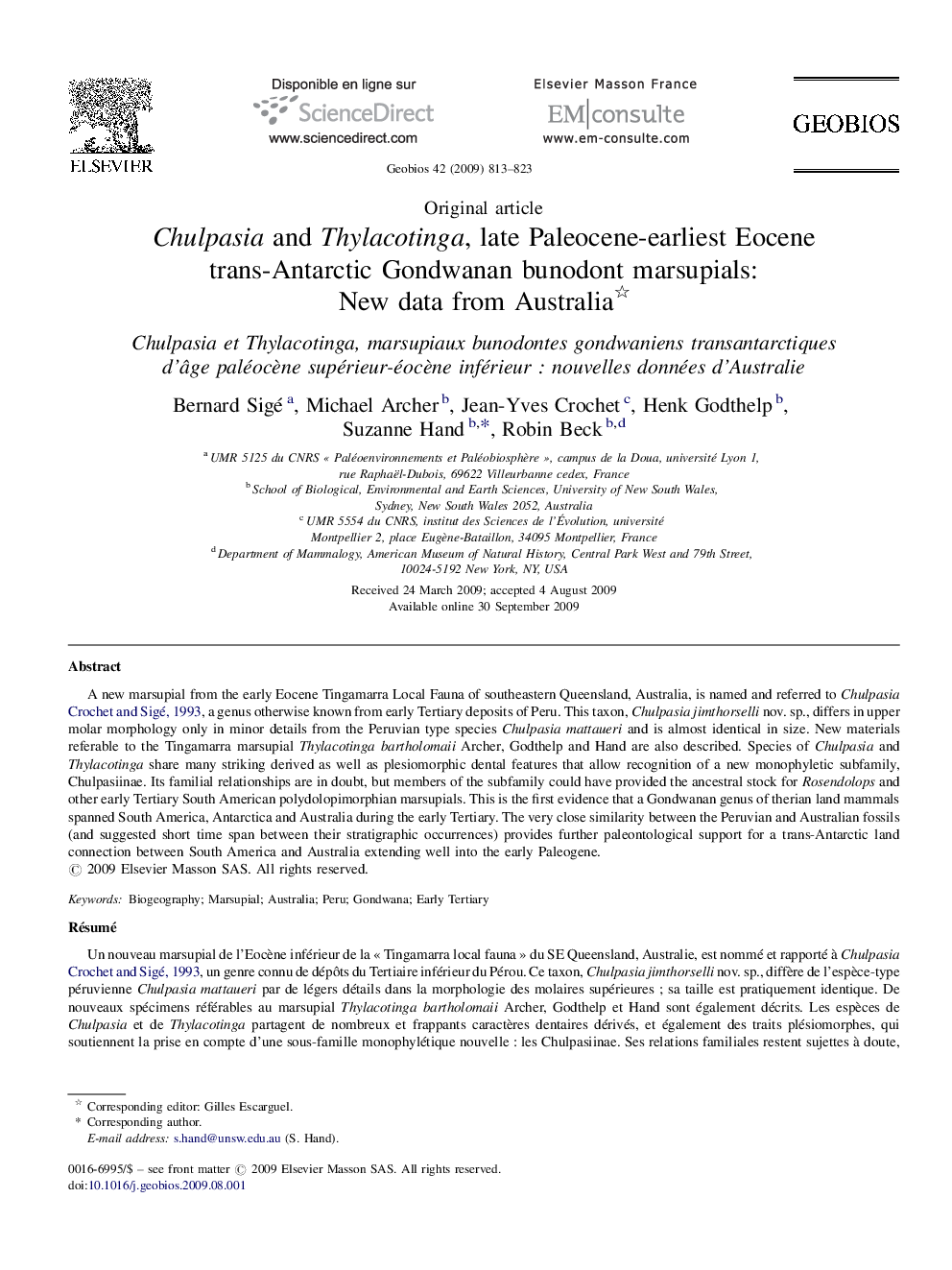| کد مقاله | کد نشریه | سال انتشار | مقاله انگلیسی | نسخه تمام متن |
|---|---|---|---|---|
| 4748453 | 1360107 | 2009 | 11 صفحه PDF | دانلود رایگان |

A new marsupial from the early Eocene Tingamarra Local Fauna of southeastern Queensland, Australia, is named and referred to Chulpasia Crochet and Sigé, 1993, a genus otherwise known from early Tertiary deposits of Peru. This taxon, Chulpasia jimthorselli nov. sp., differs in upper molar morphology only in minor details from the Peruvian type species Chulpasia mattaueri and is almost identical in size. New materials referable to the Tingamarra marsupial Thylacotinga bartholomaii Archer, Godthelp and Hand are also described. Species of Chulpasia and Thylacotinga share many striking derived as well as plesiomorphic dental features that allow recognition of a new monophyletic subfamily, Chulpasiinae. Its familial relationships are in doubt, but members of the subfamily could have provided the ancestral stock for Rosendolops and other early Tertiary South American polydolopimorphian marsupials. This is the first evidence that a Gondwanan genus of therian land mammals spanned South America, Antarctica and Australia during the early Tertiary. The very close similarity between the Peruvian and Australian fossils (and suggested short time span between their stratigraphic occurrences) provides further paleontological support for a trans-Antarctic land connection between South America and Australia extending well into the early Paleogene.
RésuméUn nouveau marsupial de l’Eocène inférieur de la « Tingamarra local fauna » du SE Queensland, Australie, est nommé et rapporté à Chulpasia Crochet and Sigé, 1993, un genre connu de dépôts du Tertiaire inférieur du Pérou. Ce taxon, Chulpasia jimthorselli nov. sp., diffère de l’espèce-type péruvienne Chulpasia mattaueri par de légers détails dans la morphologie des molaires supérieures ; sa taille est pratiquement identique. De nouveaux spécimens référables au marsupial Thylacotingabartholomaii Archer, Godthelp et Hand sont également décrits. Les espèces de Chulpasia et de Thylacotinga partagent de nombreux et frappants caractères dentaires dérivés, et également des traits plésiomorphes, qui soutiennent la prise en compte d’une sous-famille monophylétique nouvelle : les Chulpasiinae. Ses relations familiales restent sujettes à doute, mais des membres de cette sous-famille pourraient avoir constitué le stock ancestral pour Rosendolops et d’autres marsupiaux polydolopimorphes du Tertiaire inférieur d’Amérique du Sud. C’est ici la première évidence qu’un genre Gondwanien de thériens mammaliens terrestres s’est répandu en l’Amérique du Sud, Antarctique et Australie pendant le Tertiaire inférieur. L’étroite similarité entre les fossiles du Pérou et d’Australie (et le court intervalle chronologique suggéré entre leurs positions stratigraphiques) donne un nouveau soutien paléontologique au prolongement bien marqué, durant le Paléogène ancien, d’une connexion transantarctique terrestre entre l’Amérique du Sud et l’Australie.
Journal: Geobios - Volume 42, Issue 6, November–December 2009, Pages 813–823